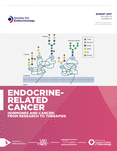Plasma membrane ion channels and epithelial to mesenchymal transition in cancer cells
- 1The School of Pharmacy, The University of Queensland, Brisbane, Queensland, Australia
- 2Mater Research Institute, The University of Queensland, Brisbane, Queensland, Australia
- 3Translational Research Institute, Brisbane, Queensland, Australia
- Correspondence should be addressed to G R Monteith; Email: gregm{at}uq.edu.au
-
Figure 1
Epithelial to mesenchymal transition (EMT). EMT is a reversible process whereby epithelial cells with polygonal morphology, apical–basal polarity, and high cell–cell/cell–ECM adhesion, and stationary position acquire mesenchymal features including spindle-like morphology, anterior–posterior polarity, cell–cell/cell–ECM dissociation and enhanced motility. EMT can be induced by microenvironmental factors including growth factors, cytokines and hypoxia. The reverse process of EMT is called mesenchymal to epithelial transition (MET).
-
Figure 2
Plasma membrane ion channels. Plasma membrane calcium channels include Orai (activated by Ca2+ store depletion), transient receptor potential (TRP), P2X (activated by ligands such as ATP), and voltage gated Ca2+ channels (VGCC). Plasma membrane sodium channels include voltage-gated sodium channels (VGSC), sodium leak channel (NALCN) and epithelial sodium channel (ENaC). Plasma membrane potassium channels include voltage gated channels (VGKC two-pore domain (K2P) channels, Ca2+-activated channels (KCa) and inwardly rectifying channels (IRK). Plasma membrane chloride channels include maxi channels, cystic fibrosis transmembrane conductance regulator (CFTR), Ca2+-activated channels (CaCC), ligand-gated channels (LGCC), volume-regulated anion channels (VRAC), and the chloride channel superfamily (CIC).
- © 2016 Society for Endocrinology












